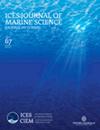Predicting trawl catches using environmental DNA
IF 3.4
2区 农林科学
Q1 FISHERIES
引用次数: 0
Abstract
Quantifying the biomass, or number of individuals, diversity, and distribution of marine species is a critical aspect of understanding and managing marine ecosystems. In recent years, there has been growing interest in using environmental DNA (eDNA) for marine ecosystem management and biodiversity assessment. However, the main challenge hindering eDNA applicability has been the inability to infer absolute species abundances from multispecies analysis (eDNA metabarcoding). In this study, we demonstrate a way forward by estimating the abundance of commercially important fish species in a Norwegian fjord using a joint Bayesian statistical model of traditional trawl-catch data and molecular data derived from eDNA. Using this model, we accurately predict out-of-sample trawl catches using eDNA alone. Moreover, our model provides empirical estimates for key processes linking marine eDNA concentration to the fish population abundance estimated from trawl observations, including trawl catchability, DNA shedding, degradation, dilution, transport, recovery rate, and isolation efficiency. These processes, including amplification efficiencies correcting for Polymerase Chain Reaction (PCR) bias, are species-specific and enable the translation of eDNA metabarcoding data into abundances. These findings have broad implications for the use of eDNA in marine ecosystem management and conservation efforts.利用环境 DNA 预测拖网渔获量
量化海洋物种的生物量(或个体数量)、多样性和分布是了解和管理海洋生态系统的一个重要方面。近年来,人们对利用环境 DNA(eDNA)进行海洋生态系统管理和生物多样性评估的兴趣与日俱增。然而,阻碍 eDNA 应用的主要挑战是无法从多物种分析(eDNA 代谢编码)中推断出绝对的物种丰度。在这项研究中,我们利用传统拖网捕获数据和eDNA分子数据的贝叶斯统计模型,估算了挪威峡湾中重要商业鱼类物种的丰度,为今后的研究指明了方向。利用该模型,我们仅使用 eDNA 就能准确预测样本外拖网渔获量。此外,我们的模型还提供了海洋 eDNA 浓度与拖网观测所估算的鱼类种群丰度之间的关键过程的经验估计值,包括拖网捕捞能力、DNA 脱落、降解、稀释、运输、回收率和分离效率。这些过程(包括校正聚合酶链式反应(PCR)偏差的扩增效率)具有物种特异性,可将 eDNA 代谢编码数据转化为丰度。这些发现对在海洋生态系统管理和保护工作中使用 eDNA 具有广泛的意义。
本文章由计算机程序翻译,如有差异,请以英文原文为准。
求助全文
约1分钟内获得全文
求助全文
来源期刊

ICES Journal of Marine Science
农林科学-海洋学
CiteScore
6.60
自引率
12.10%
发文量
207
审稿时长
6-16 weeks
期刊介绍:
The ICES Journal of Marine Science publishes original articles, opinion essays (“Food for Thought”), visions for the future (“Quo Vadimus”), and critical reviews that contribute to our scientific understanding of marine systems and the impact of human activities on them. The Journal also serves as a foundation for scientific advice across the broad spectrum of management and conservation issues related to the marine environment. Oceanography (e.g. productivity-determining processes), marine habitats, living resources, and related topics constitute the key elements of papers considered for publication. This includes economic, social, and public administration studies to the extent that they are directly related to management of the seas and are of general interest to marine scientists. Integrated studies that bridge gaps between traditional disciplines are particularly welcome.
 求助内容:
求助内容: 应助结果提醒方式:
应助结果提醒方式:


